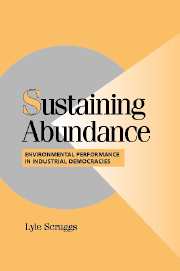Book contents
- Frontmatter
- Contents
- List of Figures and Tables
- Preface
- 1 INTRODUCTION
- 2 MEASURING NATIONAL ENVIRONMENTAL PERFORMANCE
- 3 ECONOMIC DEVELOPMENT, GEOGRAPHIC ADVANTAGE, AND ENVIRONMENTAL PERFORMANCE
- 4 PUBLIC OPINION, ENVIRONMENTAL MOBILIZATION, AND ENVIRONMENTAL PERFORMANCE
- 5 PLURALISM, CORPORATISM, AND ENVIRONMENTAL PERFORMANCE
- 6 POLITICAL INSTITUTIONS
- 7 CHECKING THE ROBUSTNESS OF THE RESULTS
- 8 CONCLUSION
- Appendix I Estimated Measures of Environmental Performance
- Appendix II Institutions for Environmental Policy Making in Fourteen Countries
- References
- Index
- Titles in the series
7 - CHECKING THE ROBUSTNESS OF THE RESULTS
Published online by Cambridge University Press: 07 December 2009
- Frontmatter
- Contents
- List of Figures and Tables
- Preface
- 1 INTRODUCTION
- 2 MEASURING NATIONAL ENVIRONMENTAL PERFORMANCE
- 3 ECONOMIC DEVELOPMENT, GEOGRAPHIC ADVANTAGE, AND ENVIRONMENTAL PERFORMANCE
- 4 PUBLIC OPINION, ENVIRONMENTAL MOBILIZATION, AND ENVIRONMENTAL PERFORMANCE
- 5 PLURALISM, CORPORATISM, AND ENVIRONMENTAL PERFORMANCE
- 6 POLITICAL INSTITUTIONS
- 7 CHECKING THE ROBUSTNESS OF THE RESULTS
- 8 CONCLUSION
- Appendix I Estimated Measures of Environmental Performance
- Appendix II Institutions for Environmental Policy Making in Fourteen Countries
- References
- Index
- Titles in the series
Summary
All too often, the results of statistical tests turn out to be fragile. That is, when one or two minor changes are made in the data or the variables in the model, originally compelling results turn out to be much less so. This issue is particularly critical in a comparative study such as this one, which relies on statistical analysis and a limited number of observations (Bernhard 1998; Bollen and Jackman 1985; Granato, Inglehart, and Leblang 1996; Jackman 1986; Western 1995). The previous chapter touched on one such problem in trying to adjudicate between competing empirically valid explanations for the same phenomenon. Given the general problems of measurement error in the concepts studied here and some of the particular problems with the environmental outcome data discussed in Chapter 2, demonstrating that the overall findings are “robust” lends them further validity.
Diagnosing influential observations
Bollen and Jackman note at the beginning of their article on influential cases in statistical analysis:
Regression analysis is a powerful tool in social research because it helps to identify and summarize relations between variables. The emphasis on generalization is critical: Among the many assumptions that statistical analysis involves is the idea that a minority of observations does not determine the obtained results. We are justly skeptical of empirical results that are unduly sensitive to one case (or a very small number of observations).
(1985: 510–11)To illustrate how this can happen, consider the following example. Figure 7.1 is a scatterplot of two variables.
- Type
- Chapter
- Information
- Sustaining AbundanceEnvironmental Performance in Industrial Democracies, pp. 191 - 203Publisher: Cambridge University PressPrint publication year: 2003



